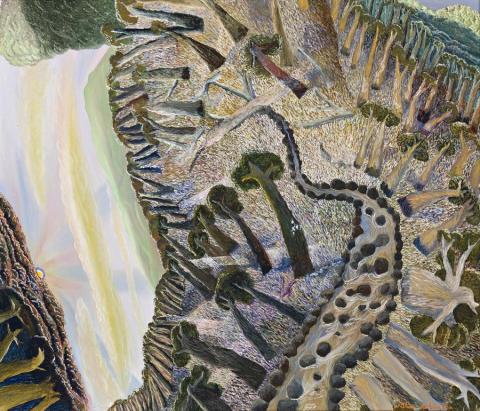FLYING FOX LANDSCAPE, 1989
WILLIAM ROBINSON
oil on canvas
56.0 x 66.0 cm
signed lower right: William Robinson inscribed and dated verso: FLYING FOX LANDSCAPE / 1989
Ray Hughes Gallery, Sydney
Private collection
Christies, Melbourne, 3 May 2004, lot 69
Private collection, Sydney
Both awe-inspiring and playful in its lyricism, Flying Fox Landscape belongs to the celebrated series of landscapes which Robinson executed following the move with his family to Beechmont in 1984 (see lots 8 & 9). In response to the enveloping mountainous terrain that now inspired his imagination, the artist abandoned conventional perspective and pictorial depth in an attempt to capture several sensations at once - thus absorbing the viewer and ensuring that they, like the artist, are an active participant in the work. As Robinson mused,
'This landscape was very elusive to me' I tried to describe the feeling of being in the landscape and walking around in it - climbing grassy hills, looking up through the gum trees to the sky, and down steep cliffs to the valley below; being blown by strong winds, caught in lightning and rain; being in the landscape with a torch and looking for cows, and with the night sky so brilliant with the moon and stars, encountering dingoes, snakes, kangaroos, birds. To look up and down almost at the same time; to have a feeling of time; the beginning and movement of day and night, and be aware of the revolving planet may be revealed in the same work.
'If I want to attempt this simultaneous vision I must abandon the concept of one position of the eye and theoretically re-position it several times within the memory of the landscape. Because I am involved with memory of an experience in a landscape including time spent in the landscape, I have shifted the position of my vision sometimes into the painting itself looking out from the painting to be met by a view looking in from outside the painting. The painting somehow has to become the reality in which I move. It is an extension of these primal feelings as I walk in the landscape. In a painting I am moving position and seeing the landscape from different viewpoints within the picture itself. Known reality and seen reality as memory in a painting are important to me, and I have tried to submerge the construction with intuitive feeling for the landscape. The painter has only a flat picture or canvas - all else is illusion. My concerns with construction were necessary to find the possibilities of the paintings. I feel I had to take you in this direction, but I do not want to give the impression that my work is other than intuitive.'1
1. Robinson, W., 'The Story of these Paintings' in Klepac, L., William Robinson, The Beagle Press, 1995, p. 40
VERONICA ANGELATOS
